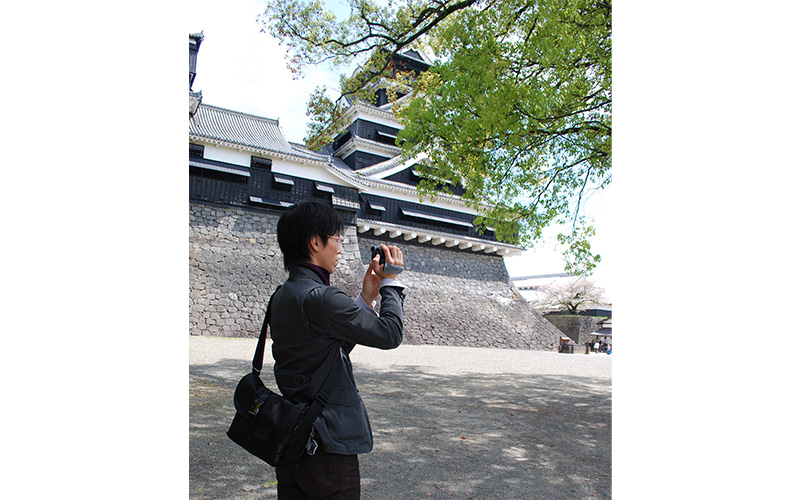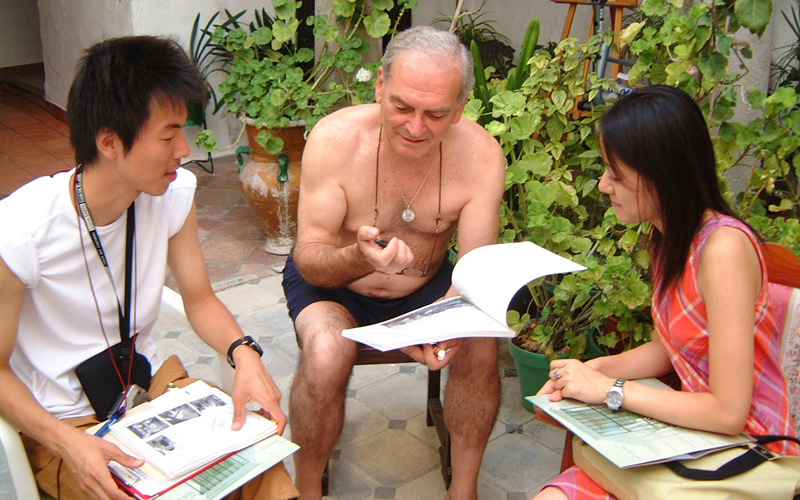Notices
Tsuyoshi Kishigami, Manager, Contents Planning Department, Cultural Business Promotion Division, Toppan Printing Co.
- March 16, 2021
Profile.
Mr. Tsuyoshi Kishigami
After graduating from Hosei University Second Middle and High School, he entered the Department of Architecture Faculty of Engineering in 1998, completed a master's degree in construction engineering at the Graduate School of Engineering in 2004, and joined a CG image production company. 2008, he joined Toppan Printing Co. In the book "The City and Countryside of Andalusia" (Kajima Press) edited by Jinnai Laboratory, published in 2013. is in charge of "Chapter 2: Arcos de la Frontera - City in the Sky.
Using the power of digital technology to convey the charm of cultural assets inherited from our predecessors to as many people as possible.
Mr. Takeshi Kishigami is involved in the construction of digital archives and content production at Toppan Printing Co. He says that the many culture shocks he received during fieldwork in the Jinnai Laboratory during his university days have led him to where he is today.
Communicating cultural assets is my life's work
My job is to create digital archives to pass on cultural properties inherited from our predecessors to future generations, and to use these archives to develop interactive contents to convey the appeal of cultural properties to many people today.
At the first company I worked for, I mainly produced urban planning videos, but I was lucky enough to be involved in a digital archive project for the Louvre Museum's "Venus de Milo" and was fascinated by the depth of cultural properties, which contain the lives and thoughts of our ancestors. This led me to want to work to convey the learning and excitement of cultural properties through the power of digital technology, and I joined Toppan Printing, which is actively developing this field.
I am currently working on a project to support the restoration and reconstruction of Kumamoto Castle, which was severely damaged by the earthquake. In fact, I have had a connection with Kumamoto Castle for a long time. I had visited the castle dozens of times to create a VR work to experience the castle as it was before it was destroyed by fire in the Civil War during the Meiji era, as the centerpiece content of a tourist facility that opened in 2011. I still remember the feeling of not being able to stand still when I saw on the news how the stone walls that were burned behind my eyes had collapsed.

During the conceptual phase of the "Kumamoto Castle" VR project. This work is shown at the "Wakuwakuza" historical and cultural experience facility.
Fortunately, Toppan Printing had about 40,000 pieces of recorded data, so they developed a "stone wall matching system" with Kumamoto University to identify the original locations of 100,000 collapsed stones, and are now working with local governments and researchers to match them.
I believe that if we can successfully fuse the two, rather than treating CG and VR as digital and cultural properties as analog, we can utilize the strengths of each and create new value.
Numerous fieldwork experiences in the Jinnai Laboratory
When I was a high school student, I became interested in computer graphics and chose the Department of Architecture Faculty of Engineering with the light feeling that I could study something related to it. In my first class with Professor Hidenobu Jinnai, my eyes were glued to the slides of a labyrinth-like Middle Eastern city, and I was sucked in by his explanation of how the climate and lifestyle could be seen from there.
The first fieldwork I did in Jinnai's lab was in Kabukicho, Shinjuku. I enjoyed sketching the chaotic buildings that had been repeatedly extended and reconstructed, and imagining how this part of the building must have been used as an escape route, or how it must have housed a shady office (......). Even now, the process of imagining various stories based on the materials is one of the most exciting parts of digitally recreating cultural assets.

Fieldwork in Andalusia. Mr. Kishigami is on the left. The man in the center is an artist, and we talked about the city's formative aspects while drawing pictures with each other.
After graduation, I wanted to engage in creative activities without being concerned about finding a job, but on the advice of my parents, I decided to delve a little deeper into architectural and urban research in order to broaden the scope of my creative work, and entered graduate school. At the same time, I studied computer graphics in earnest at a vocational school.
During my graduate school summer vacation overseas fieldwork, I was in charge of the village of Arcos de la Frontera, called the "City in the Sky," in the Andalusia region of Spain, where I conducted a survey and interviewed people living in old buildings.
While many graduates of the Department of Architecture apply what they learn through fieldwork to architectural design, my fellow students in the Jinnai Laboratory had a wide range of career paths, including fashion, advertising, and video, and I also found employment at a CG video production company.
Do something out of the ordinary and you will discover something new
As can be seen from the Kumamoto Castle project, digital archiving and VR technology are used not only to convey the appeal of cultural assets, but also to solve social issues such as regional revitalization and tourism promotion.
The "Happiness Cultural Properties Project," launched in October 2020, is one such project. Amid the prolonged Corona disaster, which has discouraged travel, the project provides contact with cultural properties, their regions, and their people through online tours, and returns profits to local communities. The first tour destination is Kofukuji Temple in Nara, where I was in charge of digital archiving in 2016, and remote viewing and other activities can be enjoyed from the comfort of your home. In December, we will also launch an online virtual space tour of the Tokyo National Museum.
Looking back on my student days now, I feel that the many culture shocks I experienced have led me to where I am today. Often, when I was walking with Mr. Jinnai, I would lose my sense of humor as he walked by.
I used to think that the trick to discovering various attractions was to go into alleys and actively get lost. I encourage all students to actively do something out of the ordinary and receive culture shock. Just by walking down a different street than usual, you will discover something new.
(First published in the January/February 2021 issue of Hosei, a public relations magazine)

